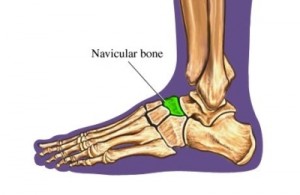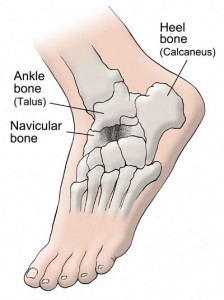Navicular Bone is found in the human foot and helps in the distribution of weight through the foot. It is also found in the hoofs of horses. Read on to know all about the bone in humans.
Navicular Bone Definition
It is a small bone located in the human foot and is one of the seven tarsal bones. The name is derived from the fact that its appearance resembles that of a small boat, resulting from a strong concave proximal articular surface. The term “hand navicular” or “navicular bone,” formerly referred to as the “scaphoid bone”, actually indicates a carpal bone found in the wrist.
Navicular Bone Location
This bone is situated on the medial side of the foot and forms a proximal articulation with the talus and distal articulation with all the cuneiform bones. It may occasionally be articulated laterally with the human cuboid bone.
Navicular Bone Development
The navicular structure has to undergo a particular process during the development of the foot bones in order to reach complete maturity. It is initially a cartilaginous bone which gradually progresses and calcifies into its strong form.
Navicular Bone Functions
It is an important part of the human medial longitudinal arch, which is the highest among the three arches of the foot. This arch plays a significant role in the even distribution of body weight through the bones in the foot. The bone also helps to hold the arteries running through the foot.
Navicular Bone Problems
There are several conditions that can affect this bone causing pain and discomfort in the foot.
Accessory Navicular Bone
It is a very common disorder occurring when the three cuneiforms composing this bone fail to calcify as a unit during its development. In other words, the cuneiforms do not fuse together properly, causing the most-medial third bone to protrude along the medial arch of the foot. The bone sticking out in this abnormal fashion tends to put pressure on the two tendons and ligaments that line it. Protrusion of the bone can be harmful to the tendons of peroneus brevis muscle (situated furthest from the bone attachment) and peroneus longus muscle (extending to the posterior part of the ankle) as well as the posterior talofibular ligament (extending upward along the calf muscle) of the foot.
This condition is often referred to as “Extra navicular bone.” It may also result from a plantar medial enlargement of the tarsal navicular. The disorder puts the tendons under stress and makes them wear away, leading to sharp pain in the foot with increased activity.
Navicular Bone Fracture
It is a common injurious condition affecting athletes. Risk factors for this fracture include:
- Kicking with the front part of the foot
- Changing direction suddenly while running
- Wearing tight-fitting shoes
- Jumping without proper prior preparation
There are four types of fracture of this bone:
- Cortical avulsion fracture
- Tuberosity avulsion fracture
- Body fracture
- Stress fracture
Navicular Bone Fracture Symptoms
The different types of fractures in this bone cause the following signs and symptoms:
- Mild to moderate pain in middle portion of the top of the foot
- Pain that may tend to radiate along the foot arch
- Pain that increases with activity and can be kept in control with plenty of rest
- Change in gait
- Pain in only one foot
- Swelling of the painful foot
- Tenderness on the inside aspect of the top middle part of the foot
Navicular Bone Dislocation
Dislocation or displacement of this bone may occur due to some severe injury, trauma or a fall. Sometimes, the displacement may occur along with fracture. It is advisable to consult a doctor immediately if the presence of this condition is suspected.
Calcaneonavicular Coalition
It is a form of a tarsal coalition between the navicular bone and the calcaneus (heel bone). A coalition is a connection between two bones which can lead to pain and discomfort. It may involve bones, cartilage, and fibrous tissue. The typical symptoms of calcaneonavicular coalition include bilateral pain and stiffness in the foot.
Kohler Disease
It refers to a pediatric condition involving the navicular bone in which a part of the bone gets destroyed (Avascular necrosis) due to extreme compression. Boys aged above four years are more at risk of developing this disease. It is characterized by the symptoms of swelling, pain, and limpness. Kohler Disease is completely curable. The recovery time required for this disorder ranges between 12 and 15 months.
Treatment for Navicular Bone Disorders
Some of these problems can be cured by physical therapy while the doctor may sometimes also prescribe medications for keeping the pain and inflammation under control. Walking casts are sometimes used for relieving the pain and reducing the difficulty in walking. Diagnostic tests like X-ray, MRI and CT scans are generally used for diagnosing many of the conditions, such as:
- Broken navicular bone
- Kohler Disease
- Calcaneonavicular coalition
- Navicular bone dislocation
- Navicular bone fracture
Surgery may be necessary in cases where none of the more conventional treatment methods can treat the condition successfully. Severe cases of accessory navicular bone are treated with a removal surgery in which the protruding part of the bone is eliminated by the surgeon. The healing time required for the disorders depend upon the severity and type of the condition as well as the applied treatment option.
The navicular bone is an important part of the upper part of the foot. An injury to this bone can give rise to foot pain and various other symptoms. Early attention is necessary for solving any problem of the bone; otherwise, it may cause serious difficulty in walking.
Navicular Bone Images
The following pictures will help you to get an idea of the appearance and location of this bone.
Picture 1 – Navicular Bone
Picture 2 – Navicular Bone Image
References:
http://www.ivy-rose.co.uk/Define/Navicular
http://answers.yahoo.com/question/index?qid=20081106171815AA6aH7s
http://www.buzzle.com/articles/foot-bones.html
http://www.healingfeet.com/blog/sports/tough-break-fractured-navicular-bone



No comments yet.